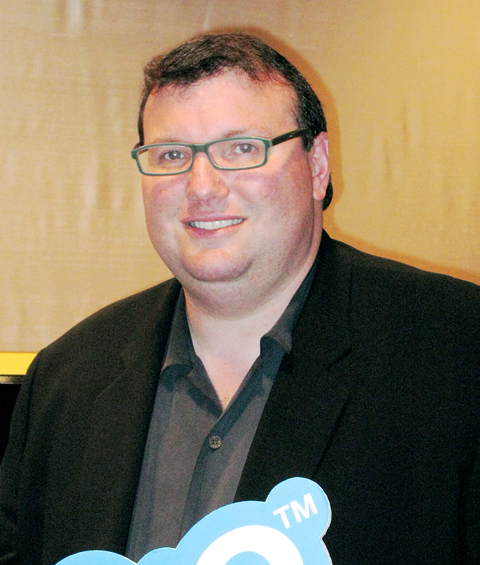Can you talk about this trip to Taiwan and what you have seen here?
Scott Durchslag: Skype has 370 million users for now, after adding 32 million users in the third quarter. That was a pretty healthy growth rate of 51 percent. And we announced our revenues of US$143 million in the third quarter, which is an increase of about 46 percent. So Skype is growing and has been consistently growing at about 50 percent per quarter.
We see significant opportunities not only to sustain that but to be able to increase it and to be able to do it not just in the markets where Skype has the deepest penetration, but in some of the markets here in Asia where we see a lot more potential.

PHOTO: ELIZABETH TCHII, TAIPEI TIMES
So the purpose of this trip was to be able to get to understand those [markets] first hand and to talk to potential partners and to think about how to broaden the business beyond just what we do for consumers, into a number of initiatives where we think there is a lot of potential in terms of business users, who are increasingly very cost-sensitive.
Another opportunity we see is in mobile [technology]. We are excited about what to do in mobile. In both PC and mobile, Taiwan plays an important role in the world’s value chain.
Why did you join Skype in July of this year after leaving Motorola about a year ago?
Durchslag: After Motorola, I have to be passionate about the product ... And really it’s a very small set of things in the world that get me incredibly excited and passionate.
I have been a Skype user since 2004 to stay in touch with my family. I always talk to my daughter twice a day.
We have a computer that sits on the breakfast table. I have lunch and she has breakfast and we get to connect and that’s something that has been very important in our family life. And that was my initial love for Skype. That was a big reason I came to Skype.
What is Skype’s mission?
Durchslag: The mission of Skype is to enable the world’s conversations. I think it’s a very noble mission because it connects friends and families in the most meaningful way possible.
What are your goals at Skype?
Durchslag: After I got to Skype, I began to see all the different opportunities to build a great business.
Skype has only scratched the surface in terms of how revenue can be generated as a business. It’s still a very young company. It’s about 550 employees. It’s a mid-size company. The opportunity to have an impact on the [company’s] culture while figuring out how to build a great company are the things I’ve gotten extremely excited about as I’ve gotten into the details.
How have your experiences at Motorola helped you do your job at Skype?
Durchslag: In three ways. Number one, part of what I did at Motorola was the brand strategy, where we took the Motorola brand, which was kind of an older brand [at the time I joined in 2002]. We aimed it at youth and got it to be kind of exciting and cool.
The beauty of Skype is that Skype is already very cool so you don’t have to reposition it. Most of Skype’s growth has been organic and viral. There hasn’t been aggressive marketing to date. So the first thing I want to do is to ramp up the marketing to really communicate even just the existing products we have.
One example is Skype-to-go, which is basically a speed-dial you put on your mobile phone and you’re able to call anywhere in the world on a Skype network.
The second opportunity to leverage is obviously in mobile phones. The first stage is making Skype accessible on the different smart phone platforms so that Skype users who want to download the software can have really good experiences that give them a high quality solution. But relatively few users are that sophisticated.
So, the second step is to start to get it pre-loaded by different original equipment manufacturers (OEMs), some of whom are here in Taiwan.
The third piece is we’re starting to see operators take some interest as well. We did a Skype phone with Hutchinson in Europe that has been very, very successful. We’re starting to get interest from other operators as well. So it’s a three-prong strategy with mobile phones.
With 1.2 billion mobile phones beings sold each year and a couple of billion mobile phone users in the world, those are big numbers, even compared to Skype’s 370 million users. Being able to take Skype from your PC, taking it from work with you to your mobile phone, and eventually being able to take it into any device anywhere, any time is really our vision.
Third, part of it is really around how do we organize the company to scale and have the processes in order to be able to work professionally with our partners. Skype can’t do everything itself. We have to learn to be a great partner. We have to have an open platform that encourages people to innovate on it. So we can have an ecosystem of partners. We have 15,000 right now, I’d like it to grow by a factor of 10. We’re on 50 to 60 devices, I want to see it on hundreds of different devices.
PCHome’s (網路家庭) success here in Taiwan is our success here in Taiwan. Also, customer care is an area that I have led before globally. As we get bigger and bigger having the ability to scale [properly] is the last piece of the puzzle to success.
Who are your competitors? How are you superior to them?
Durchslag: First evidence is look at our user base and look at theirs. In our space, which is communication, there’s really nobody else that comes close. So that’s an important advantage. But it’s not enough, you can’t just sit on that.
The second part of it is the quality of the experience. If you look at [the] video quality, the voice quality, the reliability, we have the most remarkable set of engineers in that particular space. They invented the peer-to-peer architecture to be able to support this. It’s a true, true breakthrough. It gives us the ability to have zero marginal cost infrastructure to be able to support the different services we want to offer and it’s very difficult for our competitors to have the same quality or economics attached to that kind of breakthrough.
The third part is the simplicity of the experience. It’s so easy to use, and the efforts we’re making. If you look at the 4.0 Beta 2 we just launched on Oct. 1, we believe video will be the dominant medium of communications. This is something people have been talking about for a long time.
Most studies will tell you that 70 percent of what you’re understanding from me is coming from what you’re seeing, only 30 percent is coming from what you’re hearing. So what you see in 4.0 is video —big front and center — and we build the communities around that with really simple user experience.
The fourth part is no competitor has a brand like Skype. Skype’s brand awareness, equity and consideration is off the charts high. And that’s an incredible advantage competitors find difficult to replicate.
How do you break through to corporate clients?
Durchslag: Historically, Skype has offered the same product to consumers and to businesses. About 25 percent of Skype users are small and medium-sized businesses [3 employees to 250 employees], and we’re looking at starting to offer a more specialized set of business offerings. They [corporate clients] need a business control panel that lets them keep track of credits and what’s being spent by the different employees and to manage access ... So we’re rolling that out.
They need a higher service level. A business can’t just send an e-mail and wait for a response. We’ll offer premium-level service to businesses.
And the third part to be really successful with businesses is you have to have value-added resellers on the ground walking the floors of those companies. We’re looking at building a value-added reseller network through partnerships so they can sell Skype business solutions to their business customers and they can make money by being able to provide that support and day-to-day capabilities.
In the past, Skype was one size fits all, and [now] you’ll see us taking a more segmented offering as we try and take our growth to the next level.
The best recent example is our partnership with Asterisk last month.
They are the leading Linux-based PDS provider, so they will have an offering that connects with Skype networks so people can have a solution in their business that cuts their international calling costs by 80 percent and enables free Skype-to-Skype calls. There’s a big savings opportunity. It’s something worth considering in these difficult economic times.
How does Worldwide Interoperability for Microwave Access (WiMAX) help Skype?
Durchslag: WiMAX is very good for Skype. Our research and users say they want Skype persistently to be with them and it gives more meaning and presence to the capabilities, especially when we look at how to integrate Skype’s presence in desktop [computers] into other devices and to be able to keep that wherever you go.
So we’re looking at WiMAX not just in terms of connectivity to PCs, but we’re also looking at other WiMAX-enabled devices of all sorts and types.
WiMAX is starting to roll out in different countries at different times in the next year or two. We think Skype is one of the killer applications to help accelerate WiMAX adoption and it makes things easier than WiFi because you don’t have all the sign-on issues, and WiMAX has a much broader radius of coverage and better power, which means [high] quality for sustaining video connection.
So we’re really excited about WiMAX and the sooner [it is adopted] the better.

IN THE AIR: While most companies said they were committed to North American operations, some added that production and costs would depend on the outcome of a US trade probe Leading local contract electronics makers Wistron Corp (緯創), Quanta Computer Inc (廣達), Inventec Corp (英業達) and Compal Electronics Inc (仁寶) are to maintain their North American expansion plans, despite Washington’s 20 percent tariff on Taiwanese goods. Wistron said it has long maintained a presence in the US, while distributing production across Taiwan, North America, Southeast Asia and Europe. The company is in talks with customers to align capacity with their site preferences, a company official told the Taipei Times by telephone on Friday. The company is still in talks with clients over who would bear the tariff costs, with the outcome pending further

A proposed 100 percent tariff on chip imports announced by US President Donald Trump could shift more of Taiwan’s semiconductor production overseas, a Taiwan Institute of Economic Research (TIER) researcher said yesterday. Trump’s tariff policy will accelerate the global semiconductor industry’s pace to establish roots in the US, leading to higher supply chain costs and ultimately raising prices of consumer electronics and creating uncertainty for future market demand, Arisa Liu (劉佩真) at the institute’s Taiwan Industry Economics Database said in a telephone interview. Trump’s move signals his intention to "restore the glory of the US semiconductor industry," Liu noted, saying that

NEGOTIATIONS: Semiconductors play an outsized role in Taiwan’s industrial and economic development and are a major driver of the Taiwan-US trade imbalance With US President Donald Trump threatening to impose tariffs on semiconductors, Taiwan is expected to face a significant challenge, as information and communications technology (ICT) products account for more than 70 percent of its exports to the US, Chung-Hua Institution for Economic Research (CIER, 中華經濟研究院) president Lien Hsien-ming (連賢明) said on Friday. Compared with other countries, semiconductors play a disproportionately large role in Taiwan’s industrial and economic development, Lien said. As the sixth-largest contributor to the US trade deficit, Taiwan recorded a US$73.9 billion trade surplus with the US last year — up from US$47.8 billion in 2023 — driven by strong

STILL UNCLEAR: Several aspects of the policy still need to be clarified, such as whether the exemptions would expand to related products, PwC Taiwan warned The TAIEX surged yesterday, led by gains in Taiwan Semiconductor Manufacturing Co (TSMC, 台積電), after US President Donald Trump announced a sweeping 100 percent tariff on imported semiconductors — while exempting companies operating or building plants in the US, which includes TSMC. The benchmark index jumped 556.41 points, or 2.37 percent, to close at 24,003.77, breaching the 24,000-point level and hitting its highest close this year, Taiwan Stock Exchange (TWSE) data showed. TSMC rose NT$55, or 4.89 percent, to close at a record NT$1,180, as the company is already investing heavily in a multibillion-dollar plant in Arizona that led investors to assume